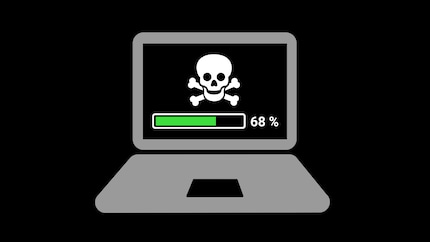
On today's menu: a Russian HDRip with a German SD source
If you think we're going to show you a new way to download or stream movies from illegal sources, you're going to be disappointed. Our tutorial is about how to create a new video file from various audio and video sources.
All right, it's not all legal, at least not from the point of view of our European neighbours. I'm quite happy to be able to (still) download files from Switzerland without breaking the law. 😜
Our starting situation: a broken drive
A colleague owns the Blu-Ray "Avengers: Age of Ultron". Even though it's not the best of the Marvel films, she'd love to see it again. Unfortunately, her Blu-Ray player has given up the ghost, and her computer doesn't have a disc drive. It's also nicer to watch these kinds of films on the big screen. What to do?
Possible solutions: time invested and results
As I'm a big film buff, I stream my films on my devices from a NAS. In general, I only use DVDs and Blu-Rays once after I've bought them: when I copy (rip) the film and include it in my NAS database. Given that ripping, and especially converting films, is time-consuming (at least for the computer), I don't always feel like sticking to it. After all, why bother? So I often look for my films on the Internet.
I also own the Avengers Blu-Ray, but haven't ripped it yet. This is the perfect opportunity to make my colleague happy by copying the film or finding an alternative source.
Legal downloading from an illegal source

The first thing I'm wondering is what medium I'm going to download the film to. I certainly have an external hard drive somewhere, but it's 2018. There are certainly more practical solutions. I don't want to have to lug it everywhere. A USB stick should do the trick. Luckily, I've got one at home. Shoot, it's only got 8GB. I'll have to download and prepare the film at 720 p (HD) instead of 1080 p (Full HD).
After a few searches on the Internet, I find what I'm looking for. Unfortunately, the German versions are too big (15.5 GB) for my USB stick or only available in SD quality (the resolution of a DVD). So I decided to download a Russian version of around 7 GB. I add a German SDRip; I'll use its audio track. The download takes about 20 minutes.
Containers and codecs
Containers

Both the digital world and shipping use containers that work in a similar way: they contain audio and video material, subtitles or chapters. For example, you can choose from several languages on your media player. Films often seem more authentic in the original version. So I always include the original sound and subtitles* in my personal database. The best-known container format file extensions are AVI (Audio Video Interleave), MOV (QuickTime) or MKV (Matroska). The MKV format generally allows alternative content to be added. As well as supporting numerous codecs, this is one of the reasons why pirates have been using Matroska for many years.
*Note about subtitles: When certain scenes in a film are in a foreign language, add «Forced Subtitles» (forced subtitle tracks) to understand even the most obscure of dialects. These files contain only the subtitles for the corresponding scenes.
The codecs

A codec compresses. It reduces the size of your audio and video files:
Audio CDs originally had an original capacity of 74 minutes (650 MB). The data is not compressed, but available in pulse code modulation (PCM) format. If you had a 128GB audio player, you could record 201 CDs on it.
If you compress your CDs with an MP3 codec, you can record many albums, depending on the bitrate used. The highest bitrate (320 kbit/s) would allow you to record 755 CDs on 128 GB.
We can therefore choose the size of a file thanks to codecs and bitrates. Different codecs and bitrates obviously have different effects on the quality of audio and video files. But I won't go into detail.
Here we go - we "mix" ourselves a new film
1. Downloading the software
To "mix", we need MKVToolNix. This is a kit of programs designed for creating MKV files, the essential component of which is mkvmerge GUI.
The tool works on many operating systems. On Windows, you can choose between an installer and a portable version:
Go to the official download page... (in English)
2. A first look at the software
Once the installation is complete, we launch MKVToolNix GUI. [[image:12394327 "The tool is certainly not very pretty, but it gives nice results if used correctly."]]
MKVToolNix supports many audio and video containers, codecs and subtitle formats. It is used to create a new MKV file or modify existing files. The possibilities are numerous: among other things, you can modify tags, delay the audio track or create chapters.
3. Importing the Russian source file
The software opens to the "Multiplexer" tab. We won't venture much further. At the top left, you can add source files with a right click or by dragging and dropping the files. You can also use the "Add source files..." button at the very bottom of the window. [[image:12394419 "The source files are added."]] [[image:11816202 "You can also import the files by dragging and dropping them."]]
Once the import is complete, the tracks and chapters contained in the file are displayed in the bottom left-hand corner. You can see what content is involved (audio and video codec, chapter, subtitle), whether the item needs to be copied for output, what language it has been assigned, whether the track needs to be played back, and so on. assigned to it, whether the track should be loaded by default, whether it should be forced, and other properties (resolution, number of audio channels). [[image:11816533 "Once the import is complete, the contents of the downloaded data are listed."]]
4. Deleting unwanted items
As you may have noticed from the screenshot above, each item is preceded by a small ticked box with which you choose which items will be played in the target file. We remove the Russian audio track by unticking it. Now only the high-resolution video, a DTS English subtitle track and the film's chapters are selected. [[image:11817814 "The unnecessary audio track is removed by unchecking the box."]]
5. Importing the German source file
Two new elements appear after adding the German AVI file. We disable the video in DVD resolution. All the elements of the future target file to be copied are now selected. [[image:11818698 "We remove the video track from the German source."]]
6. Changing properties (language, track name, "default track" signal)
You can move the files around in the right order with the mouse to get a good overview of your project. I put the HD video track at the very top of my list, followed by the German AC-3 track (Dolby Digital 5.1), the English DTS track and the chapters. [[image:11819619 "Move items around to tidy things up and keep a good overview of your project."]]
In the fourth and fifth columns of the screenshot below, you can see which languages and track names have already been assigned a value/description. We recommend that you enter the correct values for the audio tracks, otherwise you won't know which track to choose when you want to change languages in the video player.
When you select a track, you can then modify its properties in the right half of the tool. We start by clicking on the video track.
The properties of the video track
Check/edit the following properties under "General options": the track name (if necessary, you can add a hint to it), the language (I choose the language of the original audio) and the "default track" signal (it determines whether the item should be played by default). [[image:11820185]] [[image:11820672 "I am changing the video track options."]]
The German audio track properties
Here I also change the name of the German audio track and select the correct language. I select "yes" under the "default track" signal. [[image:11820557]] [[image:11820674 "The signal «default track» determines whether the item is played directly on launch in the player."]]
The properties of the English audio track
Unlike the German audio track, I select "no" under the "default track" signal. The audio track is available, but it won't play automatically. [[image:11822477]] [[image:11822513 "As we have already selected an audio track as the default track, I choose «not», or «automatically determine»."]]
7. Creating (multiplexing) the new film file
Everything is ready for us to play the new file. The software of course offers other useful options. For example, in the «Target tab», you can enter the title of the file (not to be confused with its name). Or if you notice that an audio track is not synchronised with the video track, correct its properties under «Default timestamps and duration». Add German subtitles if you wish. Our project needs no further settings.
There are just two small steps left:
- Choose a destination file and the name of the target file at the bottom of the tool.
- Click on "Start multiplexing" and wait for the new file to be created.

The result is just fine
We open the new file in a player (VLC Media Player) (in German). The video created from the Russian source with German audio is played. When we change the language, the track name we had chosen appears. [[image:11831673]] [[image:11831780 "The name of the track we chose earlier appears in the player."]]
My colleague is pleased. The MKV container supports almost all devices, which is very convenient. All you have to do is insert the USB stick into the port on your Smart TV, and you're done.
Finally, I'd still like to inform you that if your files are larger than 4GB, you should format your USB flash drive to the "NTFS" (or "exFAT") file system. Many USB sticks are already formatted in Werk FAT32 or a later version, but this system does not support files larger than 4 GB.
I find my muse in everything. When I don’t, I draw inspiration from daydreaming. After all, if you dream, you don’t sleep through life.
From the latest iPhone to the return of 80s fashion. The editorial team will help you make sense of it all.
Show all